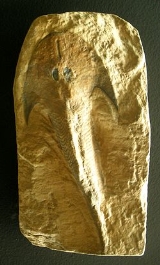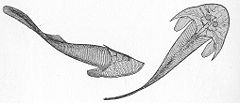
Cephalaspis
Encyclopedia
Cephalaspis was a genus of armored goldfish
-sized to trout
-sized detritivorous fish that lived in freshwater streams and estuaries of early Devonian
Western Europe. It is a member of the Osteostraci
, one of many groups of Palaeozoic armoured jawless fish.
s, as well as to serve as a source of calcium for metabolic functions in calcium-poor freshwater environments. It had sensory patches along the rim and center of its head shield, which were used to sense for worms and other burrowing organisms in the mud.
or sturgeon
. It moved its plow-like head from side to side, Cephalaspis easily stirring sand and dust into the water, along with revealing the hiding places of its prey, digging up worms or crustaceans hidden in the mud and algae, as well as sifting through detritus (inferred from its lack of jaws and inability to bite).
suggested that Cephalaspis, or one of its relatives, was an ancestor to jawed fish and other gnathostomes.
However, Cephalaspis belongs to the Osteostraci, a group which is widely believed to be the sister group to all jawed vertebrates . So whilst Cephalaspis was not a direct ancestor of the jawed vertebrates, Cephalaspis and jawed vertebrates nevertheless shared a common ancestor.
 As discussed above, Cephalaspis was featured in Walking with Monsters
As discussed above, Cephalaspis was featured in Walking with Monsters
, being pursued by the giant marine scorpion
, Brontoscorpio anglicus
. Cephalaspis first appeared in the earliest Devonian, whereas B. anglicus is known only from the latest Silurian
. The program suggested that Cephalaspis, like salmon
, migrated
upstream to fresh water habitats to spawn, but there is no evidence to prove this behavior.

Goldfish
The goldfish is a freshwater fish in the family Cyprinidae of order Cypriniformes. It was one of the earliest fish to be domesticated, and is one of the most commonly kept aquarium fish....
-sized to trout
Trout
Trout is the name for a number of species of freshwater and saltwater fish belonging to the Salmoninae subfamily of the family Salmonidae. Salmon belong to the same family as trout. Most salmon species spend almost all their lives in salt water...
-sized detritivorous fish that lived in freshwater streams and estuaries of early Devonian
Devonian
The Devonian is a geologic period and system of the Paleozoic Era spanning from the end of the Silurian Period, about 416.0 ± 2.8 Mya , to the beginning of the Carboniferous Period, about 359.2 ± 2.5 Mya...
Western Europe. It is a member of the Osteostraci
Osteostraci
The class Osteostraci was a group of bony-armored jawless fish, termed "ostracoderms", that lived in what is now North America, Europe and Russia from the Middle Silurian to Late Devonian....
, one of many groups of Palaeozoic armoured jawless fish.
Anatomy and morphology
Like its immediate osteostracan ancestors, Cephalaspis was heavily armored, presumedly to defend against predatory placoderms and eurypteridEurypterid
Eurypterids are an extinct group of arthropods related to arachnids which include the largest known arthropods that ever lived. They are members of the extinct order Eurypterida ; which is the most diverse Paleozoic chelicerate order in terms of species...
s, as well as to serve as a source of calcium for metabolic functions in calcium-poor freshwater environments. It had sensory patches along the rim and center of its head shield, which were used to sense for worms and other burrowing organisms in the mud.
Diet
Because its mouth was situated directly beneath its head, Cephalaspis was thought of as being a bottom-feeder, akin to a heavily armoured catfishCatfish
Catfishes are a diverse group of ray-finned fish. Named for their prominent barbels, which resemble a cat's whiskers, catfish range in size and behavior from the heaviest and longest, the Mekong giant catfish from Southeast Asia and the second longest, the wels catfish of Eurasia, to detritivores...
or sturgeon
Sturgeon
Sturgeon is the common name used for some 26 species of fish in the family Acipenseridae, including the genera Acipenser, Huso, Scaphirhynchus and Pseudoscaphirhynchus. The term includes over 20 species commonly referred to as sturgeon and several closely related species that have distinct common...
. It moved its plow-like head from side to side, Cephalaspis easily stirring sand and dust into the water, along with revealing the hiding places of its prey, digging up worms or crustaceans hidden in the mud and algae, as well as sifting through detritus (inferred from its lack of jaws and inability to bite).
Evolutionary history and phylogeny
The makers of the documentary Walking with MonstersWalking with Monsters
Walking with Monsters is a three-part British documentary film series about life in the Paleozoic, bringing to life extinct arthropods, fish, amphibians, synapsids, and reptiles...
suggested that Cephalaspis, or one of its relatives, was an ancestor to jawed fish and other gnathostomes.
However, Cephalaspis belongs to the Osteostraci, a group which is widely believed to be the sister group to all jawed vertebrates . So whilst Cephalaspis was not a direct ancestor of the jawed vertebrates, Cephalaspis and jawed vertebrates nevertheless shared a common ancestor.
In popular culture

Walking with Monsters
Walking with Monsters is a three-part British documentary film series about life in the Paleozoic, bringing to life extinct arthropods, fish, amphibians, synapsids, and reptiles...
, being pursued by the giant marine scorpion
Scorpion
Scorpions are predatory arthropod animals of the order Scorpiones within the class Arachnida. They have eight legs and are easily recognized by the pair of grasping claws and the narrow, segmented tail, often carried in a characteristic forward curve over the back, ending with a venomous stinger...
, Brontoscorpio anglicus
Brontoscorpio anglicus
Brontoscorpio anglicus is a species of fossil scorpion. Its remains were discovered in Trimpley, Worcestershire, and the species was described on the basis of a single pedipalp. The complete animal is estimated to be at least long and aquatic. Its carnivorous diet may have consisted of worms,...
. Cephalaspis first appeared in the earliest Devonian, whereas B. anglicus is known only from the latest Silurian
Silurian
The Silurian is a geologic period and system that extends from the end of the Ordovician Period, about 443.7 ± 1.5 Mya , to the beginning of the Devonian Period, about 416.0 ± 2.8 Mya . As with other geologic periods, the rock beds that define the period's start and end are well identified, but the...
. The program suggested that Cephalaspis, like salmon
Salmon
Salmon is the common name for several species of fish in the family Salmonidae. Several other fish in the same family are called trout; the difference is often said to be that salmon migrate and trout are resident, but this distinction does not strictly hold true...
, migrated
Fish migration
Many types of fish migrate on a regular basis, on time scales ranging from daily to annually or longer, and over distances ranging from a few metres to thousands of kilometres...
upstream to fresh water habitats to spawn, but there is no evidence to prove this behavior.
External links
Paleos Vertebrates http://www.palaeos.com/Vertebrates/Units/050Thelodonti/050.700.html#Cephalaspidida

